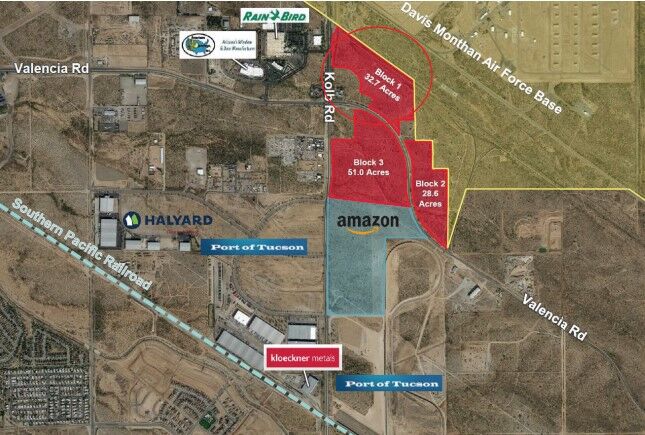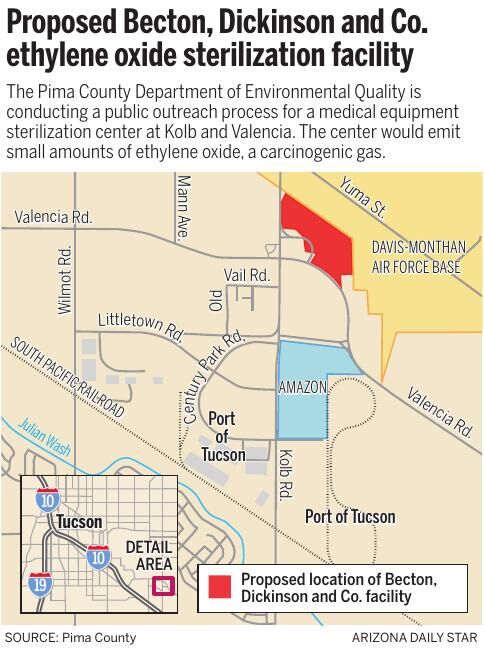Pima County is undergoing the permitting process to allow the construction of a building on the southeast side that is expected to emit trace amounts of a cancerous gas.
The facility would be built to sterilize medical equipment using ethylene oxide, or EtO, which the Environmental Protection Agency classifies as a human carcinogen.
Becton, Dickinson and Company, or BD, a multi-billion-dollar medical technology company, is seeking an air quality permit from the Pima County Department of Environmental Quality for the facility at 7345 E. Valencia Road near South Kolb Road.
Representatives from BD outlined a stringent process for control of the gas they say would prevent 99.95% of EtO used at the Tucson facility from being released into the air.
“We would not operate a facility that we didn’t feel it was safe for the community, for our employees or for the people around it,” said Troy Kirkpatrick, a spokesman for BD.
While some support the economic boost the facility could provide, environmental activists say any release of a carcinogenic gas, which could reach residential communities, is not acceptable.
Stephen Brittle, the president of the nonprofit environmental organization Don’t Waste Arizona, is actively opposing the facility and raising awareness of the nature of the chemical it would use.
“We don’t comprehend threats unless we can see them, and you got this colorless gas,” he said. “I’m really horrified, and what we can do at this point is to help get the word out. There’s reason for concern here.”
Controlling EtO emissions
BD applied for an air quality permit with the county in April. The county’s environmental quality department is responsible for monitoring air quality in the region and developing standards for new facilities with hazardous air pollutants.
The department is recommending the approval of BD’s permit, which would give the company the go-ahead to start construction. PDEQ is hosting a public outreach process before the final decision is made after the public comment period closes Dec. 17.
If approved, the nearly 140,000-square-foot facility, which neighbors the Davis-Monthan Air Force Base and an Amazon distribution facility, would likely be completed by December 2022, according to Kirkpatrick.
Natalie Shepp, the outreach and education senior program manager for PDEQ, says the proposed permit is based on standards set by the Clean Air Act, the country’s primary federal air quality law.
The draft permit allows the BD facility to emit no more than 709 pounds a year of EtO into the surrounding environment, but Kirkpatrick said the facility will likely emit less than that.
According to BD, the facility would have control measures that would get rid of 99.95% of EtO. The main control would be a catalytic oxidation system that processes emissions released within the facility before their discharge into the atmosphere, while dry bed technology would absorb “fugitive emissions,” or gas not contained by the oxidation system.
Under its county permit, BD would have to undergo certain reporting requirements, including performance testing 190 days after startup to determine the efficiency of EtO control devices and quarterly testing thereafter.
The company hired an independent consulting company to determine how EtO emissions at the facility would compare to the EPA’s 100-in-a-million risk threshold level for determining cancer risk if an individual was exposed to a certain concentration of EtO continuously for a lifetime. The results determined the average levels were five times below the EPA’s risk threshold.
“(The model) basically inputs data with the best available information they have, and then looking at the location of where people are, the model will estimate the exposures,” Shepp said. “That’s how they determine whether or not it is within a level that is safe or not safe based on the standards set by EPA.”
While potential emissions have been scientifically modeled, Brittle points out the exact amount of EtO released into the air is unknown until the facility begins operating.
“We have a chemical that could be emitted in unsafe quantities for quite a period of time before there’s any actual review by the county about whether or not it’s been done properly or if there have been exceedances,” he said.
Issues in Georgia
But the county’s role in approving BD’s air quality permit is limited to looking into compliance with federal standards. The department did not look into the company’s past, including state legislation and civil suits filed over the company’s plant in Covington, Georgia.
The company’s past “is not factored in,” Shepp said. “We really have to go by the laws that are coming from the federal level and how they’re laid out for this facility specifically.”
A 2018 EPA report known as the National Air Toxics Assessment identified a census tract near a BD facility in Covington, Georgia, had a potential total cancer risk greater than the 100-in-a-million threshold.
In September 2019, the Covington plant experienced a 54-pound leak of EtO, causing Georgia’s Attorney General Chris Carr to file a complaint in a county superior court to temporarily stop the Covington facility’s operations. The litigation was resolved through a consent order when the company agreed to shut down its Covington plant for eight days while the state Environmental Protection Division took air monitoring samples.
Kirkpatrick says the EtO levels at the Covington plant “are actually below what they found in background levels in other parts of Georgia.”
An Atlanta-based law firm filed more than 150 lawsuits against BD in June 2021 claiming EtO emissions from its Covington facility since the late 1960s have caused a “cancer cluster among those living or working within a five-mile radius of the plant,” a press release from the firm, Penn Law, said.
Darren Penn, the founder of the law firm, said the claims are still coming in and he expects more than 200 total cases to be filed against BD as existing cases pend in state court.
“You have exposure to the community since 1968, and then in the testing that gets done, clearly, it’s in violation of what’s allowed by law,” Penn said. “There are a number of folks who have been diagnosed with cancer in the community, and it’s a much higher rate of cancer in that community that you will see in any other average or normal population.”
BD denied the allegations in an emailed response: “As part of our commitment to employees and the communities we call home, BD has been continuously employing technology to control ethylene oxide (EtO) emissions effectively at its Covington and Madison plants for more than 20 years. BD denies all of the allegations in the civil lawsuits and will vigorously defend these allegations in court.”
Opponents of the proposed plant in Tucson point to BD’s history in Georgia as a red flag.
“(A company’s history) is important, because not all companies are good actors. You always put things in the context of who is it that’s applying for a permit,” Brittle said. “When you look at ethylene oxide facilities, and the communities that have been impacted that have discovered that they have high levels of ethylene oxide and they have high levels of cancers within communities, it’s a great concern.”
In addition to some expressing concerns about the presence of a carcinogen near residential communities, the proposed BD building would directly abut the Davis-Monthan Air Force Base. An Aug. 10 memo from County Administrator Chuck Huckelberry said the base “had expressed concern when locations were being discussed near the base and their approach/departure flight corridor.”
“EtO is highly flammable, and so people are concerned about it igniting,” Shepp said. “If a plane were to accidentally miss the runway and go into the facility, what will happen? They’re gonna have quite a bit of EtO in there and it’s flammable. So that’s what they’re concerned about.”
Davis-Monthan officials told the Star they don’t have a comment on the matter at this time. Kirkpatrick says the facility’s proximity to the base shouldn’t be a concern.
“We’re not in the flight path, and these facilities are designed in case there is an explosion. Basically, it’s like blast-proof chambers,” he said. “Not because it happens regularly, but just in case it ever did it, wouldn’t be a catastrophic event.”
Public outreach
As part of its permitting process, PDEQ conducted an environmental justice report to determine the demographics of the population within a 3-mile radius of the proposed facility — an area the department estimates contains 41,760 people.
Shepp says PDEQ does not know how far EtO from the proposed plant could travel to neighboring communities or how much EtO currently exists in the air from other sources.
The results showed the impacted population is comprised of 49% minority communities, 30% low-income individuals and 10% of people without a high school diploma — some of the demographics PDEQ considers more “at-risk” when receiving necessary access to information.
PDEQ determined “the projected emissions from the project will not result in disproportionately high and adverse human health or environmental effects on any population, including minority populations and low-income populations,” according to the report.
PDEQ is also engaging in a 90-day public outreach process. Written comments and emails will be accepted until Dec. 17, and Shepp said the department will respond to every comment. The last public forum for input in a group setting will be through a virtual public hearing Wednesday, Nov. 3.
But it’s not clear what impact the input of the public will have. The EPA has already reviewed the draft permit and determined it meets federal requirements, and according to Shepp, “PDEQ is required to issue the permit if it meets federal standards.”
The final decision is up to Ursula Nelson, PDEQ’s director.






